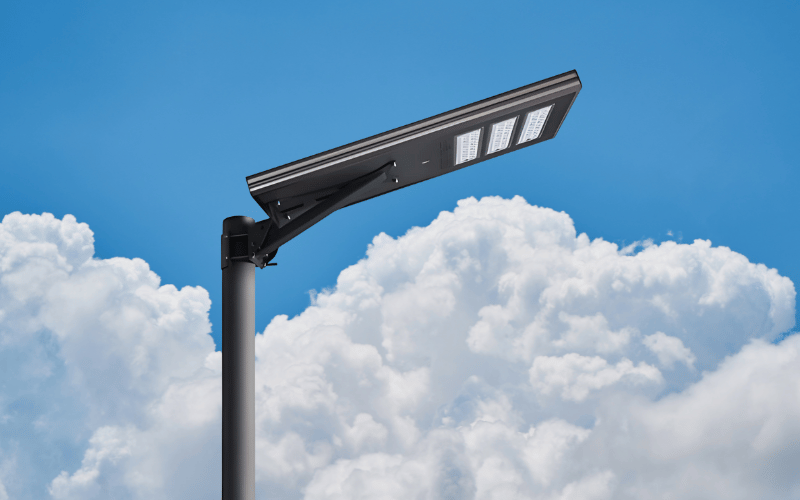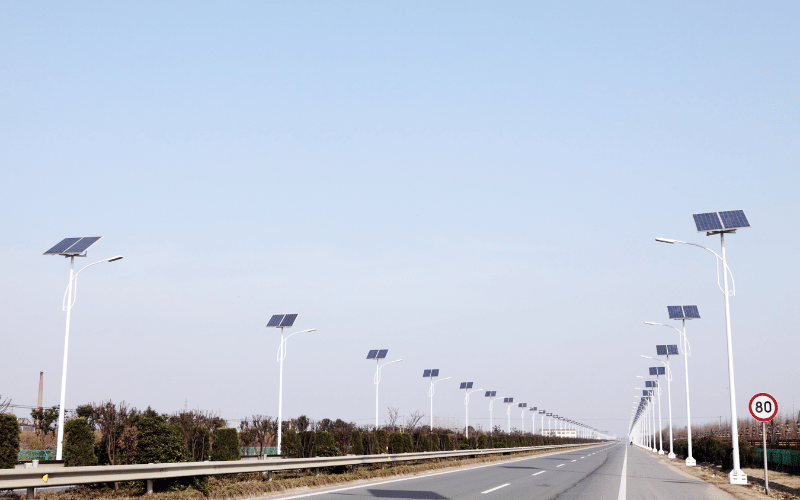Solar street lights are revolutionizing outdoor lighting by offering an eco-friendly and cost-effective alternative to traditional systems. However, one critical factor often overlooked is the height of the poles. The height of solar street lights directly impacts their efficiency, light distribution, and overall effectiveness in ensuring safety and visibility. From residential streets to highways, choosing the right height requires careful consideration of factors like light coverage, safety requirements, and environmental conditions. This guide explores the key aspects of determining the optimal height for solar street lights, offering actionable insights to help you make informed decisions.
Table of Contents
ToggleFactors Influencing Solar Street Light Height
Light Coverage Needs
The height of solar street lights directly impacts how effectively they illuminate an area, making it a critical factor in design:
- Area Size: Larger roads and open spaces, such as highways or parking lots, require taller poles (30-50 feet) to ensure the light covers a broader area. In contrast, smaller paths or residential walkways benefit from shorter poles (15-25 feet) for focused and efficient lighting. For example, suburban neighborhoods often use 20-foot poles to balance coverage and aesthetics.
- Light Intensity: Taller poles spread light over a wider area, reducing dark spots and ensuring even illumination. For instance, a 30-foot pole can illuminate an area up to 80 feet wide, while a 15-foot pole covers only 40 feet.
- Obstructions: Trees, buildings, or other structures can block light. Adjusting the pole height to clear these obstacles ensures uninterrupted lighting. In cities like Seattle, where tree canopies are common, taller poles are often used to maintain consistent light coverage.
Safety and Security Requirements
Pole height plays a vital role in ensuring safety and security across different environments:
- Crime Deterrence: Taller lights improve visibility in public spaces, making it harder for criminal activity to go unnoticed. Studies show that well-lit areas can reduce crime rates by up to 20%, especially in urban settings.
- Pedestrian Areas: Shorter poles (10-15 feet) are ideal for walkways and bike paths, providing light closer to the ground to help people see clearly and navigate safely. For example, parks often use decorative, shorter poles to enhance both safety and ambiance.
- Road Safety: Highways and wide roads require taller poles (30-50 feet) to illuminate multiple lanes effectively, ensuring drivers have clear visibility and reducing the risk of accidents. Major highway projects often use poles exceeding 40 feet to meet these requirements.
Solar Panel Performance
The height of the pole also affects the performance of the solar panels mounted on it, making it a key consideration for efficiency:
- Sunlight Access: Poles must be tall enough to keep solar panels free from shade caused by trees or nearby structures. For instance, in areas with dense vegetation, poles are often raised to ensure maximum energy generation.
- Pole Stability: Taller poles face greater wind resistance and require a strong, stable base to prevent tipping or damage. In coastal regions, where high winds are common, reinforced bases are often used for poles over 30 feet.
- Battery Charging: Proper height ensures optimal sun exposure, which is critical for efficient battery charging and consistent light output. For example, in regions with variable sunlight, pole height is carefully calculated to maximize energy collection during peak sun hours.
When choosing pole height, consider the specific needs of the area, such as coverage, safety, and solar performance. Consulting local regulations and environmental conditions can help ensure the best results.
Recommended Heights for Different Applications
Residential Streets and Sidewalks
The ideal height for solar street lights in residential areas ranges from 15 to 25 feet (4.5 to 7.5 meters). This range provides sufficient illumination for homes, sidewalks, and bike paths, ensuring safety and visibility for pedestrians and cyclists. For example, suburban neighborhoods in cities like Austin, Texas, often use 20-foot poles to create a well-lit yet unobtrusive environment that blends seamlessly with residential aesthetics. Shorter poles also help minimize light pollution, making them a practical choice for residential areas.
Commercial Areas and Parking Lots
In commercial zones and parking lots, poles should ideally stand between 25 and 35 feet (7.5 to 10.5 meters). This height allows the lights to cover larger areas effectively, reducing dark spots and enhancing security for businesses. Studies indicate that well-lit parking lots can reduce theft by up to 40%, making this height range a practical choice for safety and crime prevention. For instance, shopping centers in Los Angeles often use 30-foot poles to ensure even lighting across expansive parking lots, improving both security and customer experience.
Main Roads and Highways
For main roads and highways, the recommended height is 30 to 50 feet (9 to 15 meters). Taller poles are essential for high-speed traffic, as they provide long sightlines and ensure consistent illumination across wide lanes. Major highway projects, such as those on Interstate 95, often use poles exceeding 40 feet to meet these requirements. This ensures drivers have clear visibility, reducing the risk of accidents, especially in areas with heavy traffic or poor weather conditions.
Parks and Public Spaces
The height of solar street lights in parks and public spaces can vary significantly, typically ranging from 10 to 30 feet (3 to 9 meters). The goal is to provide adequate lighting for safety without overpowering the natural ambiance of the area. For example, in Central Park, New York, shorter decorative poles are used along pathways to maintain a welcoming atmosphere, while taller poles are placed in open spaces for broader coverage. Aesthetics also play a crucial role in these settings. As lighting designer Anya Sharma notes, “Balancing illumination with ambiance is key for parks,” emphasizing the importance of thoughtful design in creating safe yet visually appealing public spaces.
When selecting pole heights, consider the specific needs of the area, such as coverage, safety, and aesthetics. Consulting local regulations and environmental factors can help ensure the best results.
Understanding Light Spread and Illumination Levels
Beam Spread Patterns
Beam spread patterns determine how light is distributed across an area, making it essential to choose the right one for specific applications. Here’s a breakdown of the most common patterns and their uses:
- Type I: Provides a two-way distribution, making it ideal for narrow paths and walkways. For example, this pattern is often used in pedestrian alleys or bike paths to ensure focused lighting along the route.
- Type II: Designed for streets that are slightly wider than the mounting height of the light pole, offering broader coverage. This is commonly used in residential streets where the road width requires even illumination.
- Type III: Suitable for roads and general open areas, ensuring even illumination over larger spaces. Suburban streets and parking lots often use this pattern to minimize dark spots.
- Type IV: Focuses light on building fronts or walls, making it perfect for architectural lighting. For instance, commercial buildings or monuments often use this pattern to highlight their facades.
- Type V: Offers a circular distribution, making it the best choice for intersections or large open areas. A Type V pattern can illuminate a circular area up to 50 feet in diameter, ensuring visibility in high-traffic zones like roundabouts or plazas.
Always match the beam pattern to the shape and purpose of the area. For example, use Type III for wide roads and Type V for intersections to ensure optimal light distribution and efficiency.
Illuminance Standards (Lux)
Illuminance, measured in lux, defines the amount of light required for different applications to ensure safety and functionality. Here are the recommended levels:
- Pedestrian Walkways: Aim for 5-10 lux to provide sufficient visibility for walkers. For example, parks and trails often use this range to balance safety and ambiance.
- Residential Streets: Target 10-20 lux to ensure safety while maintaining energy efficiency. Suburban neighborhoods typically follow this standard to create a welcoming yet functional environment.
- Major Roads: Require 20-50 lux to ensure clear visibility for high-speed traffic. Highways like Interstate 10 often use this range to reduce accidents and improve driver confidence.
Data Point: These guidelines align with recommendations from the Illuminating Engineering Society (IES), a trusted authority in lighting standards.
Consult local lighting codes and regulations to determine the required lux levels for your specific project. For example, urban areas may require higher lux levels than rural settings to meet safety and compliance standards.
Choosing the Right Pole Material and Design
Durability and Weather Resistance
Selecting the right pole material is essential for ensuring long-term durability and resistance to environmental challenges. Here are the most common materials and their applications:
- Galvanized Steel: Known for its strength and rust resistance, galvanized steel is ideal for areas prone to harsh weather or heavy usage. For example, cities like Chicago use galvanized steel poles to withstand freezing temperatures and heavy snowfall.
- Aluminum: Lightweight and corrosion-resistant, aluminum poles are a popular choice for coastal regions where salt exposure is a concern. In Miami, aluminum poles are frequently installed to combat the corrosive effects of sea air while maintaining a sleek appearance.
- Composite Materials: These modern options combine durability with flexibility, making them suitable for areas with extreme weather variations. For instance, composite poles are often used in hurricane-prone regions due to their ability to withstand high winds without cracking or bending.
While galvanized steel offers unmatched strength, aluminum and composite materials are often preferred for their lighter weight and lower maintenance needs, especially in corrosive or high-wind environments.
Wind Load Ratings
Wind load ratings are critical, particularly for taller poles installed in windy regions. The height, shape, and location of the pole all influence its ability to resist wind forces. For example, a 30-foot pole in an open field will face significantly more wind pressure than a 15-foot pole in a sheltered urban area.
In hurricane-prone areas like Florida, poles with wind load ratings of 150 mph or higher are often required to ensure stability during extreme weather events. Additionally, tapered pole designs are commonly used to reduce wind resistance.
Always check the pole’s wind rating and ensure it meets local regulations and environmental conditions. This reduces the risk of damage or failure, especially in areas with frequent storms or high winds.
Aesthetics and Integration
The design of the pole should complement its surroundings to enhance the overall visual appeal of the area:
- Pole Style: Choose a style that aligns with the environment. Sleek, modern poles work well in urban areas, while decorative poles are better suited for historic districts or parks. For example, in Savannah, Georgia, shorter, ornate poles are used to preserve the city’s historic charm.
- Color and Finish: Poles can either blend into the background with neutral tones or stand out with bold colors, depending on the desired effect. In public plazas, custom finishes like bronze or black are often chosen to create a polished, upscale look.
Example: In historic districts, shorter, decorative poles are often used to maintain the area’s traditional charm while providing adequate lighting. For instance, in New Orleans’ French Quarter, cast-iron poles with intricate designs are a signature feature that blends functionality with aesthetics.
Thoughtful design choices ensure that poles integrate seamlessly into their environment while meeting functional requirements. Consider the area’s character and purpose when selecting pole styles and finishes.
Conclusion
The height of solar street lights is more than just a design choice—it’s a crucial factor that influences light coverage, safety, and solar panel performance. Whether it’s a 20-foot pole for a suburban street, a 40-foot pole for a busy highway, or a decorative 10-foot pole for a park, the right height ensures optimal illumination and efficiency. By considering factors like beam spread patterns, illuminance standards, wind load ratings, and material durability, you can tailor your lighting solutions to meet the specific needs of any area. Thoughtful planning and adherence to local regulations will not only enhance functionality but also create safer, more visually appealing spaces.



